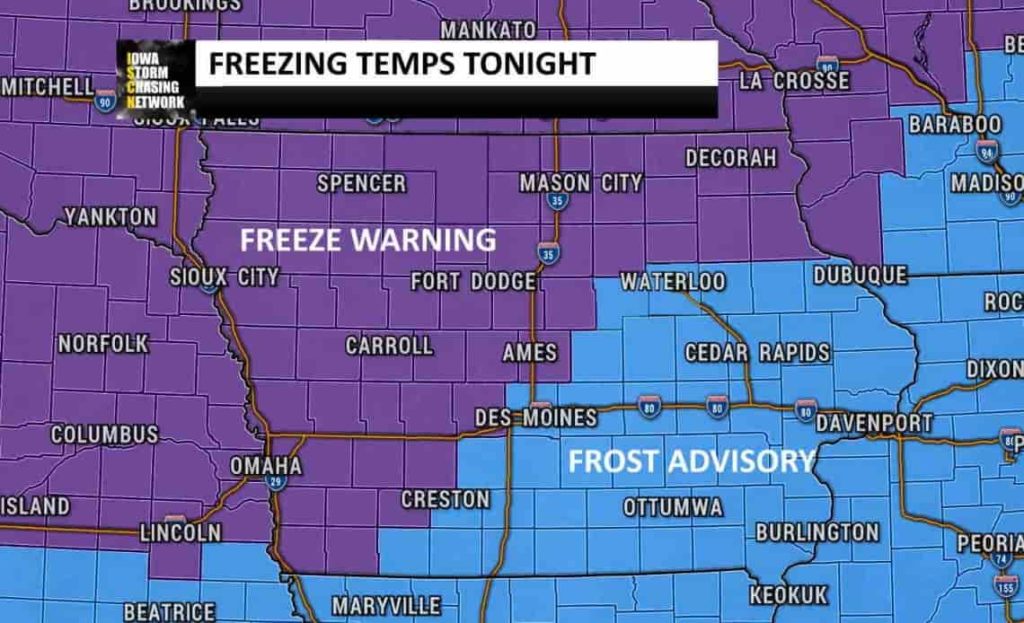Freeze Warnings vs. Frost Advisories

Last updated: August 27, 2025
When temperatures dip in spring or fall, gardeners and farmers across Iowa often hear the terms Freeze Warning or Frost Advisory. While these alerts may sound similar, they serve different purposes—and the criteria can vary depending on where you live. Understanding these alerts is important for protecting crops, landscaping, and even your home’s plumbing.
What Is a Frost Advisory?
A Frost Advisory is issued when conditions are favorable for frost formation, typically when forecast lows are between 33°F and 36°F under clear skies and light winds. Even though the air temperature might remain slightly above freezing, plant surfaces can cool more quickly, allowing frost to form.
These advisories are issued only during the local growing season—not in the dead of winter when vegetation is already dormant. For Iowa, this usually means you’ll see Frost Advisories in late April through May and again in late September through October.
What Is a Freeze Warning?
A Freeze Warning means air temperatures are expected to drop to 32°F or below, cold enough to damage or kill sensitive vegetation. The warning is usually issued when forecasters are confident freezing temperatures will occur overnight.
When Are These Alerts Issued in Iowa?
In Iowa, Frost Advisories and Freeze Warnings are most common during the shoulder seasons:
- Spring: Late April into May, when early planting and budding plants are vulnerable.
- Fall: Late September through October, when the growing season winds down and first freezes often occur.
The exact dates vary each year based on weather patterns. Iowa State University Extension provides county-by-county frost and freeze date averages, a helpful resource for farmers and home gardeners planning their growing season.
Why Criteria Differ by State
One confusing aspect of frost and freeze alerts is that criteria can differ not only between states but even between neighboring counties. That’s because each National Weather Service (NWS) Forecast Office defines the local growing season and may adjust thresholds slightly to reflect local agriculture and climate.
For example:
- Some NWS offices stop issuing frost/freeze alerts once a widespread killing freeze has occurred, signaling the end of the growing season.
- Others use a calendar cutoff date, regardless of whether plants are still growing.
- In areas with unique crops or microclimates, the criteria may be adjusted to better serve local agriculture.
Iowa is covered by five NWS offices—Des Moines, Quad Cities/Davenport, Sioux Falls, Omaha/Valley, and La Crosse—so depending on where you live, alerts may come from a different office than your neighbors just a few counties away.
How to Prepare for Frost and Freeze Events
Whether it’s a Frost Advisory or a Freeze Warning, there are steps you can take to protect your home and garden:
- Garden plants: Cover tender vegetation with cloths or frost blankets, and bring container plants indoors. Avoid plastic coverings that touch foliage.
- Crops: Harvest what you can before a hard freeze, and use irrigation or row covers for added protection.
- Homeowners: Disconnect and drain garden hoses, cover outdoor faucets, and insulate exposed pipes to prevent costly freeze damage.
For Iowans, understanding the difference between a Frost Advisory and a Freeze Warning can help prevent damage to gardens, crops, and even your home. While the criteria are broadly similar across the Midwest, the exact timing and issuance rules differ by state and even by county, depending on local climate and agricultural needs.
By paying attention to these alerts—and knowing when they matter most—you can stay one step ahead of the weather and protect what’s important.